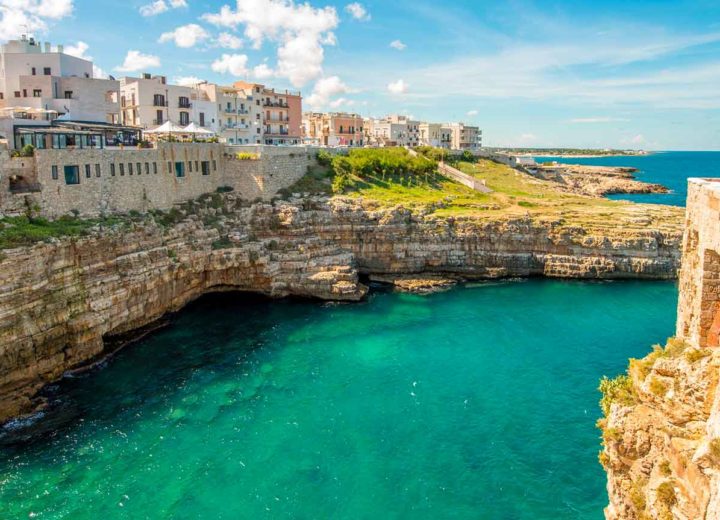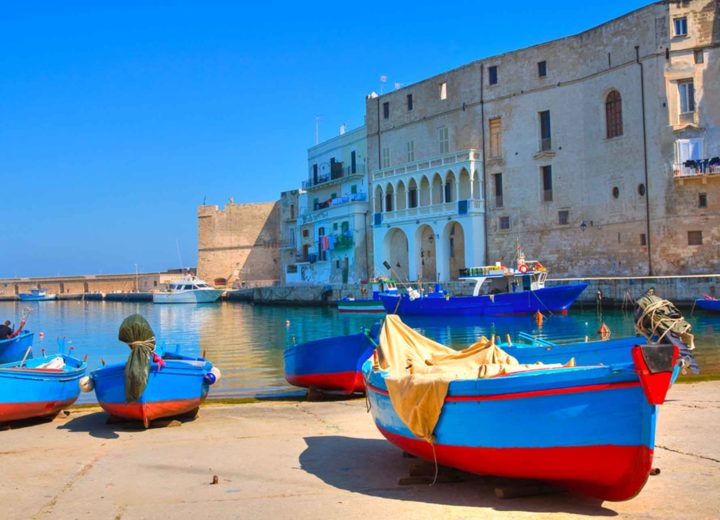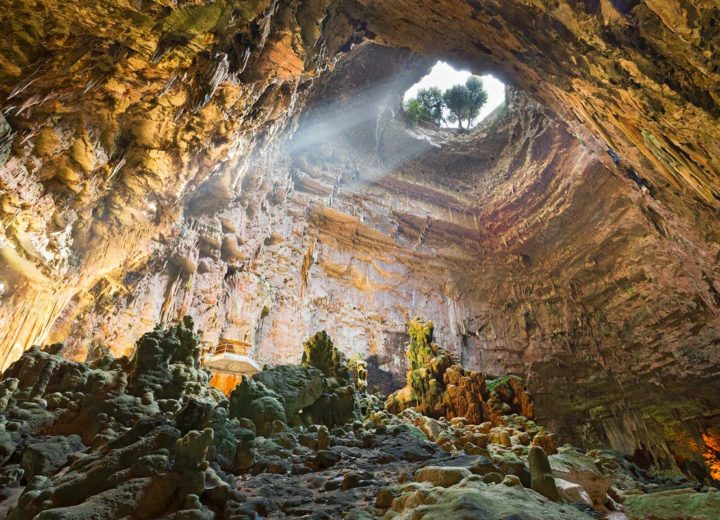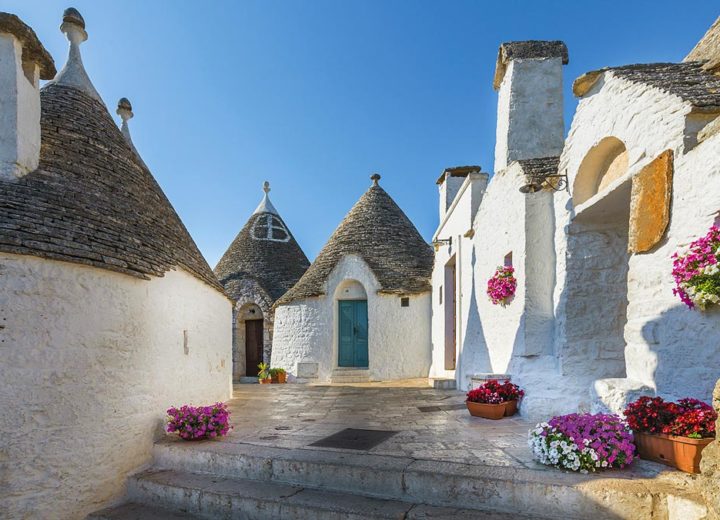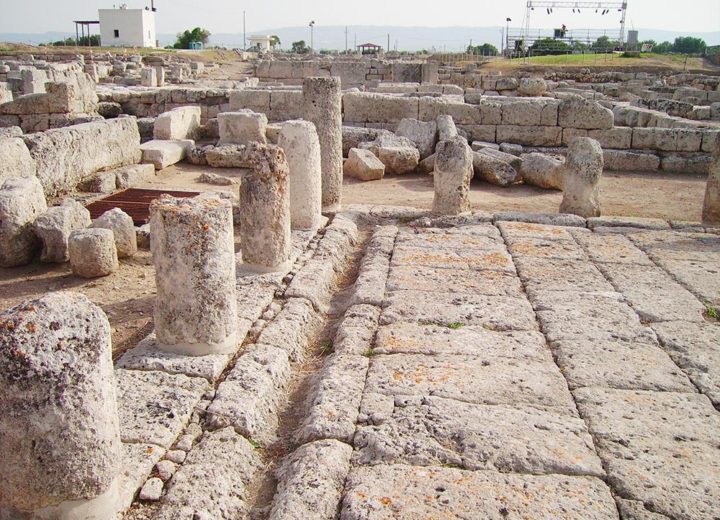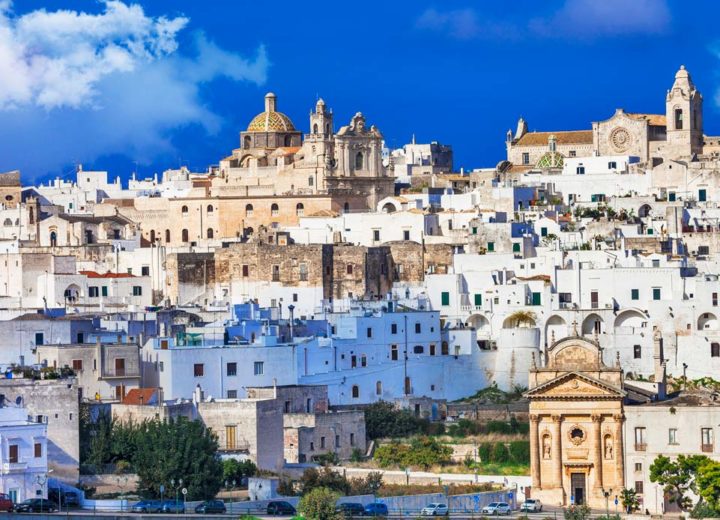Places to visit in and around Monopoli
POLIGNANO A MARE
The “pearl of the Adriatic” as Polignano a Mare is often called, is about 10 kilometers from Monopoli and about 30 from Bari. It is the hometown of Domenico Modugno, the unforgettable interpreter of “Nel blu dipinto di blu” and “Meraviglioso,” the latter song brought back into vogue some time ago by the Apulian band Negramaro. And, precisely to Modugno, a statue is dedicated on the city’s waterfront. It is understood that the singer-songwriter’s statue is not the only thing to see in Polignano. The historic center, with its Arab, Spanish and Norman footprints, attracts thousands of tourists from all over the world. Especially worth seeing is the Chiesa Matrice dell’Assunta with its unique mix of Gothic, Apulian-Romanesque and Baroque. But that’s not all, because there is Lama Monachile, the most famous of the inlets that furrow the town’s rugged coastline, to see. It lies to the west of the historic center and is particularly crowded in the summer months: the charm of the place, together with the crystal-clear sea (Blue Flag for years), make it one of the most famous and sought-after locations in all of Puglia. The Red Bull Cliff Diving, an international diving competition that, in just a few years, also thanks to Polignano’s evocative location, has gained the growing attention of the public and the media. What is very fascinating and intriguing, in the case of Polignano, is that the diving from over twenty meters takes place from the balcony of a house overlooking the sea, one of many in this wonderful town in Adriatic Puglia. Not to be missed!
MONOPOLI
GROTTE DI CASTELLANA
One of the main factors in the tourism boom in the Bari metropolitan area is definitely the Castellana Caves located in the municipality of the same name in Castellana Grotte. There are tens of thousands of visitors who flock from all over the world every year to admire this geological site less than twenty kilometers from Monopoli and about forty from the regional capital. The reason is the spectacle offered by the concretions of these caves of karst origin that extend three kilometers in length at a depth of more than 100 meters. Stalactites, stalagmites, flows, curtains, crystals and a thousand other limestone evolutions characterize this subterranean landscape first explored in 1938 by speleologist Franco Anelli, to whom the museum adjacent to the entrance is also named. In reality, that of the Castellana Caves is a landscape in the making: there is scientific awareness of the existence of other tunnels and cavities beyond those already discovered, and who knows therefore that one day it may not be possible to go even deeper than is the case today. Already what is there, however, leaves tourists spellbound, who often combine this visit with that of the trulli of Alberobello. Both locations, in fact, are part of the Murgia, a sub-region encompassed by Puglia and Basilicata, of which the stunning city of Matera (Basilicata), European Capital of Culture 2019, is also a part. For more information on the history, times and how to visit the Castellana Caves, consult the official website: www.grottedicastellana.it .
ALBEROBELLO
We mentioned in the opening that a vacation in the “Land of Bari” is not just a beach stay. Alberobello is the proven proof of the above. A UNESCO World Heritage Site since 1996, this area is about 20 kilometers from Monopoli and about 50 from the capital Bari. Its special feature are the trulli, dwellings dating back to the 16th century, with a unique conical shape and, what is more important, built without the aid of mortar. In short, dry-stone buildings made by taking advantage of the huge availability of limestone in the area. At the basis of this sui generispare building technique, however, there seems to have been a precise economic motivation: the desire, on the part of the feudal lords of the area, to evade in this way the taxes owed to the Kingdom of Naples for the settlement of new towns. A fiscal expedient, however, that evidently sharpened the wits of the local workers, who were able to pull up dwellings that were anything but precarious despite the absence of mortar. There are several things to see: the Sanctuary dedicated to Saints Cosmas and Damian; the Parish of St. Anthony of Padua, also trullo-shaped; and Casa Pezzolla, Alberobello’s historic district with the highest concentration of communicating trulli. Not surprisingly, this agglomeration was entirely renovated between 1993 and 1997 and has since housed the Museo del Territorio with its display of tools, artifacts and documents attesting to the lifestyle of the local people. Not to be missed!
EXCAVATIONS OF EGNAZIA
A few kilometers from Fasano is Egnatia, one of the most important archaeological areas in Puglia. It is an ancient urban settlement, originally the center of the Messapic civilization (a Balkan population present in Apulia since the 9th century B.C.), which, however, had its greatest phase of development in Roman times. The city port, in fact, with the Romans became a key junction for trade between the Adriatic, Aegean and Black Seas, so much so that the toponym “Egnatia” would derive precisely from the name of this maritime route, known precisely as “Via Ignazia.” However, land connections also contributed to the development of the area. To be precise, the “Via Traiana,” a Roman road connecting Brindisi and Benevento and an excellent alternative to the busier Appian Way. In short, Egnatia was for centuries a strategic commercial port of call between West and East, later falling into disgrace after the end of the Roman Empire. The archaeological history of the site begins, however, in the 19th century: first Napoleonic troops during the French Decade of the Kingdom of Naples (1806-1815) and later the local population began looting vases, bronzes, jewelry and a host of other ceramic artifacts found in the necropolis. Only in the early 1900s did the area finally pass into full state control. Even today, more than a century later, research continues, taking advantage of the presence of the nearby museum to inventory the finds as they come to light. The museum is named after Giuseppe Andreassi, superintendent for the archaeological heritage of Apulia between 1990 and 2009 and director of the archaeological area of Egnatia from the mid-1970s to the mid-1980s. More information on the history, visiting arrangements and access hours to the park and museum can be found at: www.egnazia.eu
OSTUNI
CONTACT US
Studio Cab aims to connect sellers and buyers, making it easy to sell, buy, rent the best properties in and around Monopoli. For professional evaluation of your property, to sell or buy home, contact us now. Our staff will get back to you in a short time.

